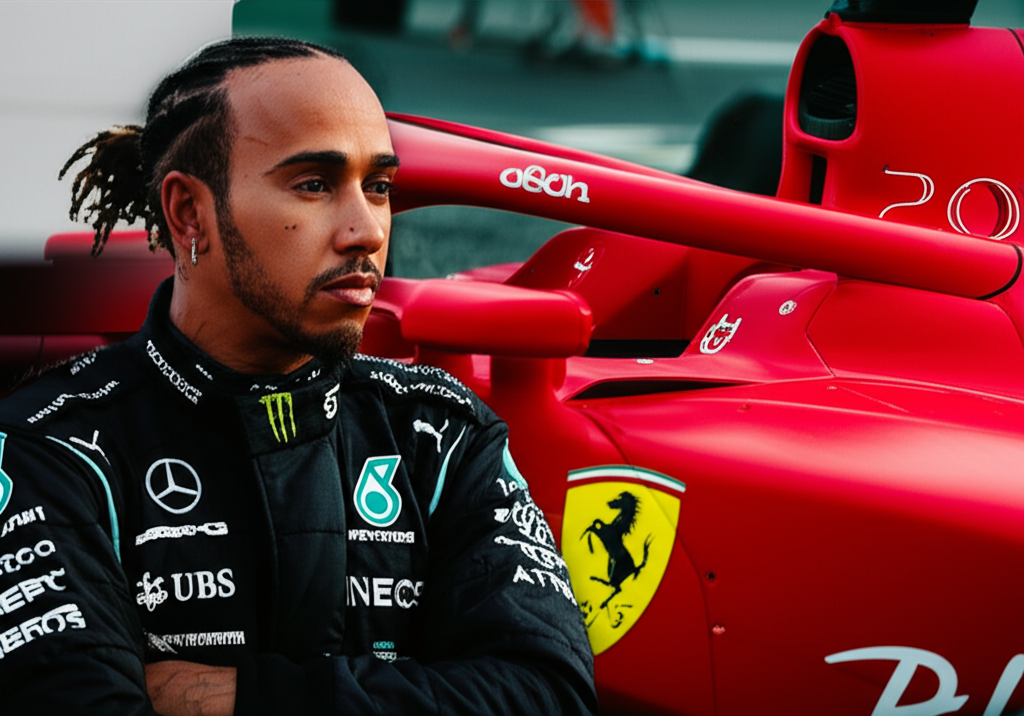Hamilton’s Ferrari Transition: A New Narrative Emerges Amidst Performance Scrutiny
Exploring the evolving dynamic and external commentary surrounding Lewis Hamilton’s inaugural season with Scuderia Ferrari.
The highly anticipated move of seven-time Formula 1 World Champion Lewis Hamilton to Scuderia Ferrari for the 2024 season has been a focal point of intense discussion within the motorsport community. While the initial fanfare surrounding the blockbuster transfer was undeniable, Hamilton’s debut season has seen him openly critique his own performances. This introspection from the celebrated British driver has fueled a broader conversation about the challenges of adapting to a new team and the pressures inherent in driving for one of Formula 1’s most iconic marques.
Hamilton’s Candid Self-Assessment
Since joining Ferrari, Hamilton has not shied away from acknowledging areas where he believes his performance has fallen short of expectations. He has publicly stated his dissatisfaction with certain aspects of his driving and the car’s setup during the early races of the season. This level of candor from a driver of Hamilton’s caliber is notable, as it offers a transparent glimpse into the meticulous self-evaluation that often accompanies elite athletic careers. His willingness to admit when he feels he is not performing at his peak provides a contrast to the often-guarded public persona of top athletes.
External Perspectives on the Transition
The public discourse surrounding Hamilton’s Ferrari tenure has also involved commentary from various figures within and around Formula 1. Reports have surfaced detailing critical assessments of the team’s internal sentiment regarding Hamilton’s arrival. For instance, one perspective suggests that a significant portion of the Ferrari team might not have actively sought Hamilton’s recruitment, with a strong internal preference for retaining Charles Leclerc as their primary driver. This viewpoint, if accurate, could indicate a complex internal dynamic at Maranello, where established hierarchies and existing driver relationships might influence team reception.
Such commentary, often originating from anonymous sources or based on speculation, highlights the inherent difficulty in definitively gauging internal team sentiment. The reality for any high-profile driver joining a new team is the need to build trust and integrate into existing structures. The pressure to perform immediately, coupled with the challenge of adapting to a different car philosophy and team culture, presents a multifaceted hurdle.
Comparing Current Performance to Expectations
It is crucial to contextualize Hamilton’s current season against the backdrop of his unparalleled success at Mercedes. During his tenure with the Silver Arrows, Hamilton secured six world championships, cementing his status as one of the sport’s greatest-ever drivers. This period was characterized by exceptional performance, both individually and collectively with the Mercedes team. The stark contrast between his dominant years and the current challenges at Ferrari naturally invites scrutiny.
However, Formula 1 is a sport where team dynamics, car development, and driver adaptability are constantly at play. Ferrari, while a legendary team, has undergone its own periods of rebuilding and restructuring. Hamilton’s arrival is part of a longer-term vision for the Scuderia, aiming to restore their championship-winning legacy. Therefore, judging his tenure solely on early-season results without considering the broader strategic context might offer an incomplete picture.
The Role of Team Dynamics and Driver Adaptation
The integration of a driver like Lewis Hamilton into a team as significant as Ferrari involves more than just on-track performance. It encompasses technical feedback, collaborative development, and building rapport with engineers and mechanics. Hamilton’s experience and technical acumen are undeniable assets, but these must be effectively channeled within the Ferrari operational framework. The team’s response to his feedback and the collaborative spirit in addressing performance gaps are critical factors in the success of this partnership.
Conversely, the dynamics between Hamilton and his teammate, Charles Leclerc, are also a subject of interest. Leclerc, a highly talented and established driver within Ferrari, represents a significant benchmark. The relationship between the two drivers, their level of mutual respect, and their ability to work together for the team’s overall benefit will undoubtedly shape Ferrari’s trajectory. External reports of internal preferences for one driver over another, while speculative, underscore the delicate balance of team composition and the impact it can have on morale and performance.
Navigating the Challenges Ahead
As the Formula 1 season progresses, the narrative surrounding Lewis Hamilton at Ferrari will continue to evolve. His personal commitment to improvement, combined with Ferrari’s ongoing development efforts, will be key determinants of their success. The team faces the dual challenge of improving car performance and integrating Hamilton seamlessly into their long-term strategy. The public nature of Formula 1 means that every performance, every qualifying session, and every race result will be subject to intense scrutiny and commentary.
For fans and observers, it is important to distinguish between established facts, verifiable data, and speculative commentary. The true measure of Hamilton’s impact at Ferrari will likely be understood over a longer period, as the team works through the development cycle and both driver and team adapt to one another. The initial period of transition is often the most challenging, and Hamilton’s willingness to be open about these challenges suggests a genuine commitment to overcoming them.
Key Takeaways for Observers
- Lewis Hamilton has been candid about his own performance during his debut Ferrari season.
- External commentary suggests potential internal divisions within Ferrari regarding Hamilton’s recruitment.
- Hamilton’s transition involves adapting to a new team culture and car philosophy, a process that takes time.
- The relationship and collaboration between Hamilton and Charles Leclerc are crucial for Ferrari’s future success.
- Judging the partnership solely on early-season results may not reflect the full picture of the long-term strategy.
The journey of Lewis Hamilton at Ferrari is a compelling storyline in the current Formula 1 landscape, offering insights into the pressures and complexities faced by elite athletes during career transitions. Understanding the various perspectives, while maintaining a critical eye on the source of information, allows for a more nuanced appreciation of the challenges and opportunities that lie ahead for both the driver and the iconic Italian team.


























